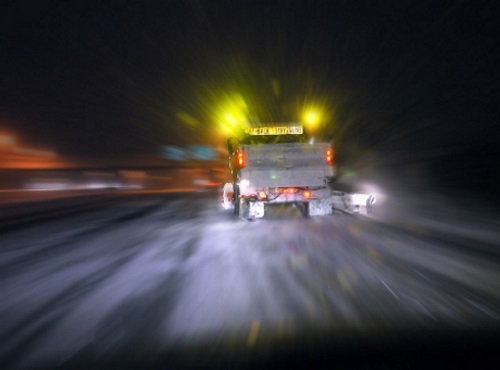When it snows in Minnesota, drivers want the roads and bridges cleared – now.
However, simply dumping mass amounts of salt on the roads is an outdated practice for the Minnesota Department of Transportation. Today, the agency is taking a new strategic – and more environmentally friendly – approach to how it removes snow and ice.
[Above photo by the Minnesota DOT]
“We want to minimize what we use,” explained Sue Lodahl, Minnesota DOT’s acting state maintenance engineer. “It’s about using the right chemical at the right time in the right location.”
During the 2020-2021 winter season, the agency spent $116 million and used more than 800 plow trucks and 354 million pounds of salt to combat 53 inches of snowfall, according to the department’s Annual Winter Maintenance Report. The salt usage was down about 15 percent from the previous year.
[To learn more about snow and ice fighting tactics, check out the winter operations podcast put together by the American Association of State Highway and Transportation Officials Snow and Ice Pooled Fund Cooperative Program, known as “SICOP.”]
The Minnesota DOT has also published “Winter Maintenance Best Practices,” a guide for using salt, with an emphasis on sustainable practices. “MnDOT seeks to reduce the use of salt on roadways while maintaining a high level of performance with regard to level of service recovery in winter operations,” the guide states.
The department’s Salt Solutions Program helps operations personnel make good decisions about selecting the best and safest materials for clearing the roads. As a result, the Minnesota DOT’s maintenance crews now have an arsenal of tools to fight snow and ice – including salt, potassium acetate, calcium chloride, sodium acetate and even beet juice.
[Editor’s note: The Minnesota DOT also began testing the technology on 10 of its snowplows in January that allows operators to activate digital highway signs to warn motorists when slow-moving vehicles are ahead on the road. That technology activates digital message signs to display certain messages as they pass, such as “Snowplow ahead, use caution” or “Maintenance vehicle ahead, use caution” during non-snow events. The message stays activated for several minutes after the snowplow passes the sign.]

Even with all the chemical options available, plain road salt – sodium chloride – is still the “go-to” material, yet it has its limitations. Salt is not effective if the temperature drops below 15 degrees Fahrenheit.
Moreover, if salt washes off the road, it can harm water, vegetation, and wildlife.
“We’re always going to use granular salt, but we’re trying to keep it on the road,” Lodahl said. “You can’t just put down salt. Otherwise, it will go into the environment.”
The Minnesota DOT also “pre-wets” the salt with truck sprayers just as it hits the road. The water helps the salt stay on the roadway, where it reacts to the heat from vehicle tires. “But if the temperature is less than 15 degrees, that’s when we move into calcium chloride,” Lodahl pointed out.
The department’s top priority is to achieve what it calls “bare lanes,” a condition in which 95 percent of the lane between the wheel tracks is free of snow and ice and travel speeds are not impacted. Last winter, the Minnesota DOT saw bare lanes 87 percent of the time. The Salt Solutions Program’s goal is to strike a balance between achieving bare lanes and protecting the environment.
In 2020, the agency also studied using potassium acetate almost exclusively on roads in Duluth, where the average daily winter temperature is 23 degrees. The study showed promise, but there are still some environmental unknowns about the long-time use of potassium acetate, Lodahl said.
“Salt is still our biggest tool, our best tool,” she explained. “Everything is going to have some environmental factor. If salt scatters, it’s not doing us any good, and it harms the environment.”
Lodahl added that salt sustainability “is very important to MnDOT. We cherish the environment and try to keep the roads safe.”
 Wildlife and Ecosystems
Wildlife and Ecosystems



